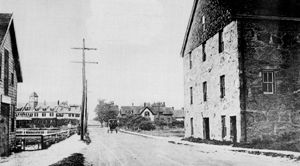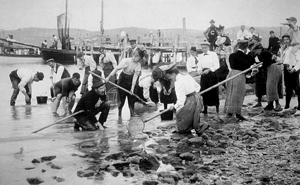
Water Street, early 1900s. Candle House at right dates to Woods Hole’s whaling days (1828–1864). Fisheries building is at left in background.

MBL botany class students during an 1895 specimen collection trip.
Woods Hole, a village in the Town of Falmouth on the southwestern corner of Cape Cod, is a world center for marine, biomedical, and environmental science.
A History of the Scientific Community
The village of Woods Hole was settled more than 300 years ago and for two centuries remained primarily a farming and fishing community. Then in 1871 the United States Commission of Fish and Fisheries (precursor of the National Marine Fisheries Service) was established, and its first director, Spencer Fullerton Baird, set up a temporary collecting station in Woods Hole to study marine animals. Attracted by the abundance of fauna and unpolluted waters, he established a permanent laboratory in the village in 1875. Soon, visiting scientists were studying local marine plants and animals, and a hatchery was organized to stock rivers with shad, salmon, and other fish.
In 1888, a second institution, the Marine Biological Laboratory (MBL), was established across the street. Its founders believed that some of the essential processes of life, such as cell division, nerve and muscle activity, and development, might be studied more easily in simple marine forms than in higher animals. Consequently, both teaching and research were begun in cellular biology, embryology, and biomedical fields as well as in marine biology in general. For almost 90 years MBL was solely a summer institution, but since the 1970s it has housed a number of major year-round programs.
The Woods Hole Oceanographic Institution (WHOI), a private nonprofit research organization originally funded by the Rockefeller Foundation, struck off in a somewhat different direction. It was incorporated in 1930 to study all branches of oceanography. Since much of the research was planned for the deep sea, the research vessel Atlantis was built and used from 1931 to 1964. In its first decade, WHOI was primarily a summer institution. During World War II it changed to a year-round operation to gather oceanographic information for anti-submarine warfare, amphibious landings, and other operations. After the war, WHOI continued to work with the government, and at present 80 percent of its annual budget is supported by federal grants and contracts.
In the 1960s, a fourth institution, the U.S. Geological Survey, headquartered its new branch of Atlantic Marine Geology here to investigate the geology and geophysics of the Atlantic, Gulf of Mexico, and Caribbean. The Sea Education Association joined the community in 1975.
Woods Hole Research Center, which followed in 1985, was founded as an institute for global environmental research by renowned ecologist George M. Woodwell, whose broad interests and achievements in environmental issues and policies have had a major impact worldwide. For its first 18 years, the Center’s headquarters were in the village of Woods Hole. In 1999, several acres of land and an old inn on Woods Hole Road were acquired which formed the basis of the WHRC Gilman Ordway Campus, now a model of green architecture and sustainable energy systems.

